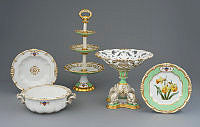Rubenstein Center Scholarship
Diversity in White House Art: Georgia O'Keeffe
Georgia O’Keeffe’s captivating flower paintings and Southwestern landscapes have made her one of the world’s most recognizable modern artists. O’Keeffe was born on November 15, 1887, and raised in Wisconsin. Throughout her childhood, she took art lessons at home with her siblings and later attended lessons at the School of The Art Institute of Chicago and the University of Virginia.1 While honing her painting skills, she earned a living by teaching art courses and freelancing in the commercial art industry.
Georgia O’Keeffe’s own artistic style was far more creative and abstract, however, inspired by artists such as Arthur Wesley Dow and Henri Matisse. In 1916, O’Keeffe celebrated her first solo exhibition, fronted by Alfred Stieglitz, a world-renowned photographer who would one day become O’Keeffe’s husband. In the years that followed, O’Keeffe and Stieglitz lived together in New York City, where she became well-known for her depictions of flowers and the New York City skyline. O’Keeffe’s abstract style was uniquely personal, simultaneously evoking themes of Surrealism, Expressionism, and Precisionism without strictly falling under any one category.

Georgia O'Keeffe, photographed in New Mexico in 1950.
Library of CongressIn 1929, Georgia O’Keeffe made her first trip to New Mexico—a journey that would transform her life and art forever. The rugged desert environment became O’Keeffe’s muse, inspiring abstract paintings of animal bones, mountains, and sand throughout her career. She returned to New Mexico each year but loved the setting so much that she eventually purchased two homes near Santa Fe. She moved to the state permanently in 1949, following the death of her husband.2
O’Keeffe continued painting through her old age, but suffered from macular degeneration, a condition that causes blurred vision and/or partial blindness. From the 1970s until her death in 1986, O’Keeffe relied on her own memory, as well as assistance from others, to complete her paintings. She explained that despite her deteriorating eyesight: “I can see what I want to paint. The thing that makes you want to create is still there.”3
Georgia O’Keeffe was highly successful throughout her life. Her work was the subject of numerous exhibitions and she earned many awards, including the Presidential Medal of Freedom and National Medal of Arts, awarded to O’Keeffe by President Gerald Ford in 1977 and President Ronald Reagan in 1985, respectively. She also holds the record for the highest price paid for a painting by a female artist.4 This 1932 painting, Jimson Weed / White Flower no. 1, sold for $44.4 million dollars in 2014; before this record-breaking auction, the painting hung in the President’s Dining Room in the Second-Floor Residence of the White House, on loan during the George W. Bush administration.5

Jimson Weed/ White Flower No. 1 (left) on display in President's Dining Room in 2007. It is the most expensive painting made by a woman in American history.
White House Historical AssociationO’Keeffe remains one of the most famous female artists in American history. In particular, she is remembered by many Americans for her colorful, enlarged depictions of flowers, a hallmark of her early professional career. Throughout history, these floral paintings have led viewers to apply a sexual analysis to the subject matter, comparing the shape, color, and reproductive nature of her flowers to female anatomy. Many speculate that these paintings reflect female empowerment, accompanying the burgeoning feminist movement of the mid-twentieth century.6 However, Georgia O’Keeffe never substantiated these claims during her lifetime. In fact, she preferred that gender be separated from her work and career, stating: “Men put me down as the best woman painter…I think I’m one of the best painters.”7
One of O’Keeffe’s early New Mexico landscapes is now a permanent part of the White House Collection. Painted in 1930, the work, titled Mountain at Bear Lake - Taos, depicts an area near Taos, New Mexico. This land is sacred to the Taos Indigenous peoples of the region.8 The oil painting features striking colors, abstract lines, and shifting light to evoke the beauty of the New Mexican desert. Mountain at Bear Lake - Taos had only been exhibited to the public once by Alfred Stieglitz; otherwise, it remained in Georgia O’Keeffe’s possession until it was gifted to the White House by the Georgia O’Keeffe Foundation, as well as William D. Rollnick and Nancy Ellison Rollnick.9

Mountain at Bear Lake - Taos hanging over the fireplace in the White House Library (2007).
White House Historical AssociationThe painting was unveiled at a ceremony in the White House East Room in 1997. First Lady Hillary Clinton told spectators: “I hope that as visitors … walk through these halls at the White House and see the O’Keeffe hanging, they too will feel more connected to our past, grateful for our present and more excited about our future.”10 The painting was initially displayed in the White House Green Room; during the George W. Bush administration, the painting was moved to its current location above the fireplace in the Library on the Ground Floor.






























































